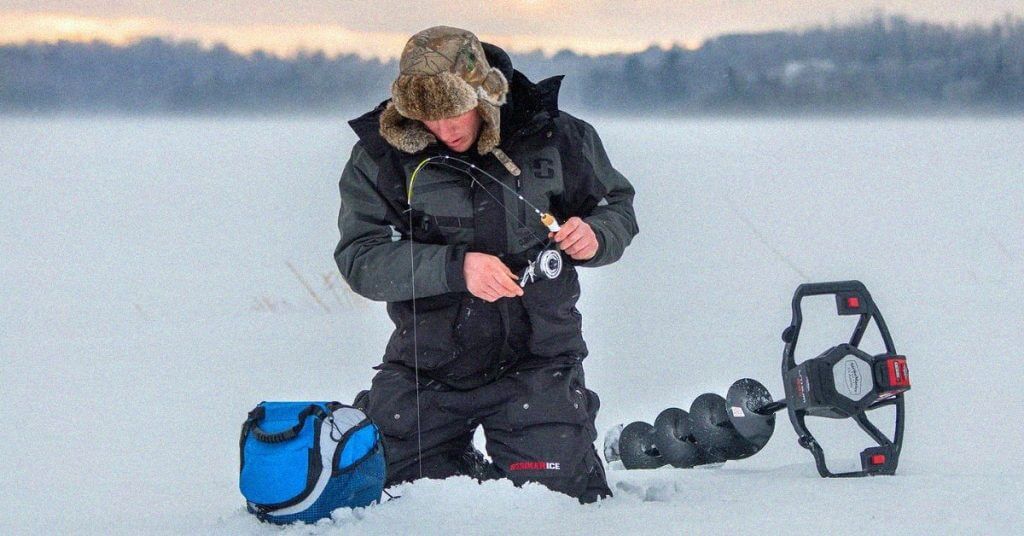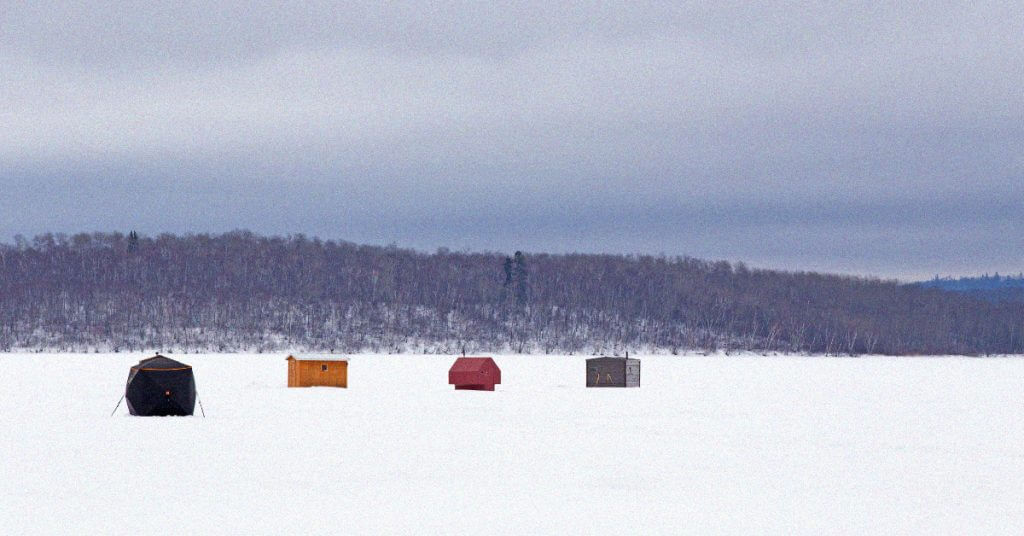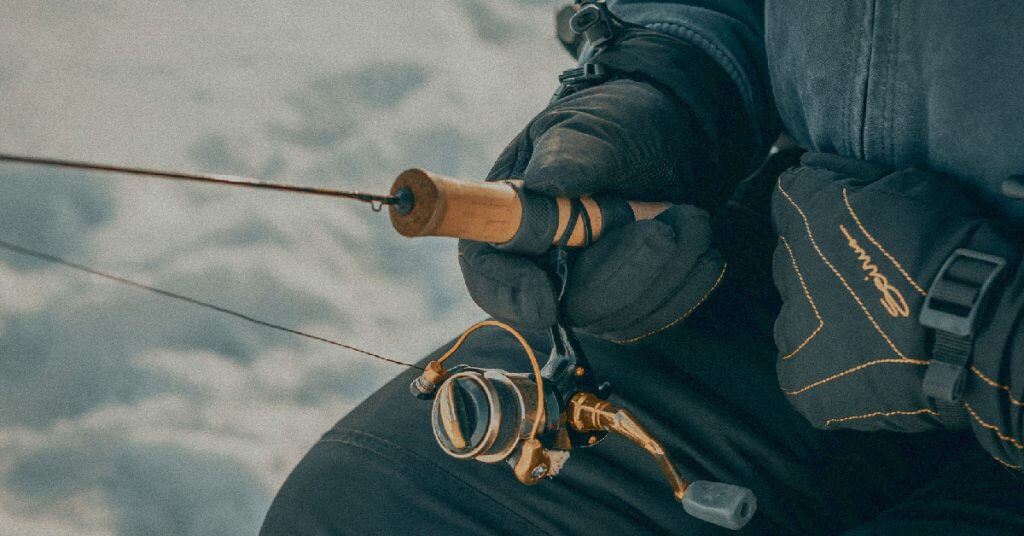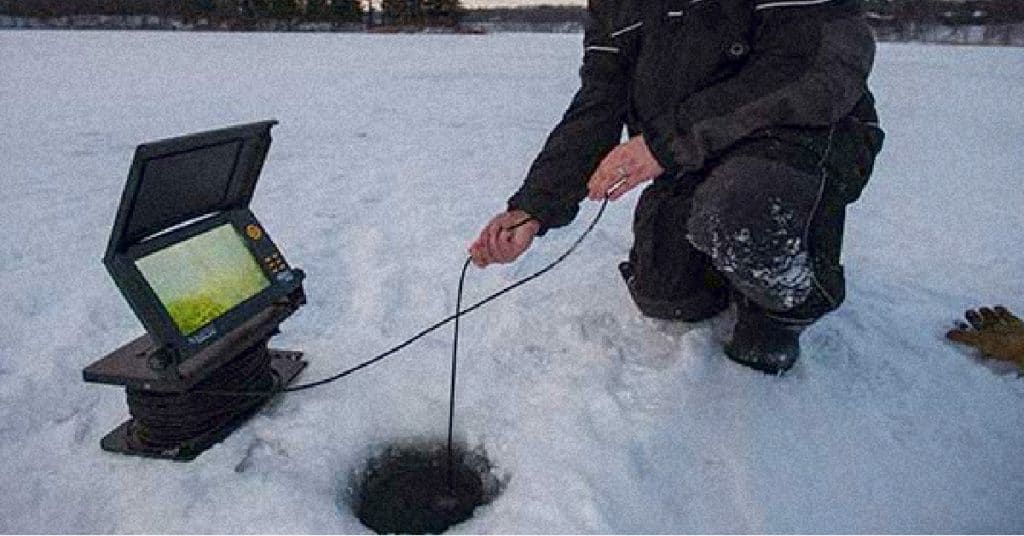When I first started ice fishing, I made the classic rookie mistake — thinking any winter boots would work on the ice.
After too many trips cut short because of frozen toes and soaked feet, I learned proper ice fishing boots aren’t a luxury — they’re essential to staying out long enough to actually catch fish.
Here are my top choices.
Last updated: December 7th, 2025
- Best Overall: Korkers Polar Vortex 1200
- Best Value: ArcticShield Cold Weather Snow Boots
- Best For Extreme Cold: Baffin Men’s Titan with Snow Collar
- Most Waterproof: Muck Boot Arctic Pro Snow Boot
- Most Comfortable: Sorel Men's Caribou Insulated Waterproof Boot
- Most Durable: LaCrosse Alphaburly Pro
- Recent Updates
- How I Test Ice Fishing Boots
- How to Choose the Best Boots for Ice Fishing
- Conclusion
- Frequently Asked Questions
Here’s a quick overview of our top picks:
| Product | Temp Rating | Material | Price | Shop At |
|---|---|---|---|---|
| Best Overall Korkers Polar Vortex 1200 Interchangeable Soles | -60°F 1200g Thinsulate™ | Rubber / EVA BOA® Lacing System | $$$ | Korkers |
| Best Value ArcticShield Snow Boots Lightweight Design | -40°F Heat-Resistant | Synthetic / Rubber Standard Insulation | $ | Amazon |
| Extreme Cold Baffin Men’s Titan With Snow Collar | -148°F Ultimate Warmth | Molded Rubber Seamless Design | $$$ | Cabela’s |
Best Overall: Korkers Polar Vortex 1200

Specs
Pros
Cons
Why I Chose Them
After testing dozens of boots over 15 years of ice fishing, I recommend the Polar Vortex 1200 because they stand alone in combining elite warmth with practical features, like interchangeable soles.
Unlike my old Baffin Impacts that wore out after two seasons, these Korkers are built to last and the replaceable soles extend their life even further.
What really sets these boots apart is their versatility across different ice conditions. Early season, when you’re dealing with wet ice and slush, the rubber soles grip perfectly. Mid-season, when everything’s frozen solid, swap to the carbide studs and you’re secure on even the slickest ice.
The BOA fit system is a game-changer for us mobile anglers — I can quickly tighten or loosen them between spots without taking off my gloves, something you can’t do with traditional laces or pull-on boots.
I’ve used these boots in everything from early December’s slop to late February’s sub-zero days. Always warm. Always dry.
Despite how badass these boots are, they aren’t perfect — as nothing is. All that insulation makes them rather heavy to lug around, though no doubt you’ll get used to it (and maybe build up your calf muscles).
Another thing I’ve heard mention of is the BOA lacing system malfunctioning, but I suspect this results from abuse or carelessness, not a defect in the design. Still, it’s something to keep in mind.
These boots are nearly $250, but the versatility, durability, and overall high quality make them worth every penny for anglers who are serious about ice fishing.
Quick advice: Check out both Korkers and Cabela’s below. Usually one or the other has them on sale.
Best Value: ArcticShield Cold Weather Snow Boots
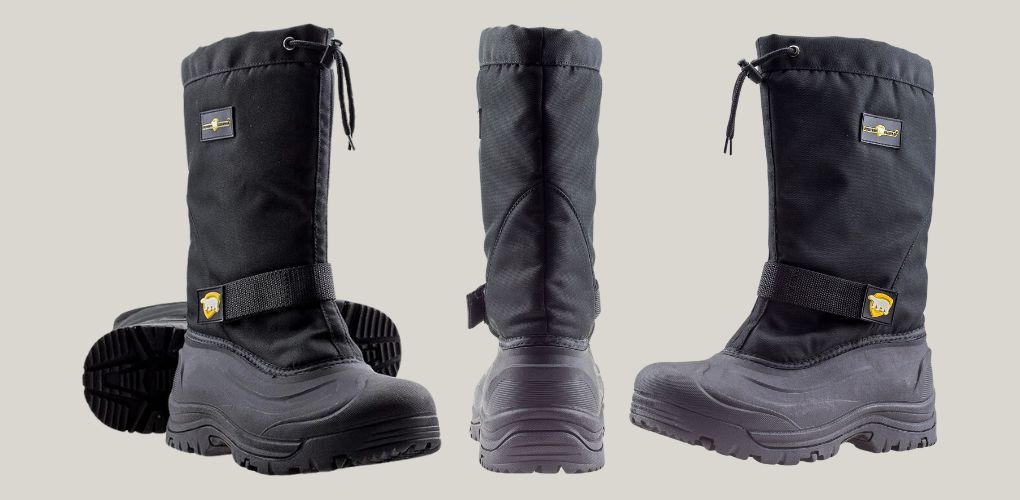
Specs
Pros
Cons
Why I Chose Them
First, let’s start with the price. These boots will run you about $50, which is what I LOVE. But when you take a closer look at them, you see they’re not too different from typical snow boots that you’d wear to shovel snow.
That’s because they’re not. They’re made with a standard “weather-resistant” material and feature a rubber sole that runs up a few inches from the bottom.
These boots are rated for -40°, but that doesn’t mean they can handle temperatures like that for a prolonged period of time. If you’re out on the ice experiencing anything below 30°, you may end up with cold feet if you don’t have super-thick, insulating socks on — and perhaps even if you do.
So, what do I like about these boots? I like that they’re lightweight, easy to walk in, and easy on the wallet. They’re comfortable, easy to put on and take off, and (most importantly) they won’t break the bank.
I believe they’ll do the trick for your occasional ice angler — with a damn good pair of socks.
But those of you who are on a fishing trip every weekend for five or more hours might want to think twice about these budget-insulated fishing boots and go with something more durable like the Baffin Titan.
Best For Extreme Cold: Baffin Men’s Titan with Snow Collar

Specs
Pros
Cons
Why I Chose Them
The Baffin Men’s Titan boots are engineered for extreme conditions, rated for temperatures far below what the average ice angler will encounter.
While you’re more likely to face temperatures around 30°–40° Fahrenheit on the ice, this exceptional cold rating means these boots can handle anything Mother Nature throws at you with ease.
One of the standout features is the one-piece molded construction with a solid rubber outsole. There are no seams to wear down over time, which means no surprise leaks mid-season.
Yes, this makes them slightly more challenging to pull on and off, but the extra two to three seconds is a small price to pay for guaranteed dry feet.
The cleat-style nonslip grip provides excellent traction on ice and packed snow, and despite their heavy-duty construction, they’re surprisingly manageable to walk in.
You might need a few trips to adjust to them, but the stability they provide on slick surfaces is worth the brief adaptation period.
However, these boots do come with some notable drawbacks. The same construction that makes them exceptionally warm also limits their breathability.
While part of keeping your feet warm is locking in heat and preventing moisture buildup (which these boots excel at), your feet might get a bit sweaty during more active periods.
The sizing is another consideration that requires careful attention. These boots run notably small and tight, especially during the break-in period.
If you prefer a roomier fit, you’ll want to go up a few sizes. Even if you’re comfortable with a snug fit, order at least one size larger than your usual — just be prepared for some initial discomfort during the break-in period.
Despite these limitations, if you’ve struggled with cold feet during previous ice fishing seasons, these boots are your solution.
Most Waterproof: Muck Boot Arctic Pro Snow Boot

Specs
Pros
Cons
Why I Chose Them
When you’re looking for the best ice fishing boots, there’s one important feature that stands above the rest: waterproofing.
In reality, a lot of these extreme temperature ratings that companies love to brag about will never apply, but the one factor that will surely make your feet cold time and time again is moisture. You need boots that will keep the snow out — not just for the first ten times you wear them but the last ten times you wear them too.
These hunting boots are made using 8mm neoprene with 2mm of high-quality EVA foam similar to Thinsulate on the footbed. I know, I know . . . fancy terminology. In short, this just means great heat retention and helps ensure your feet stay warm when you’re standing on the ice.
Moisture in your boot is the number one reason your feet will get cold, and one way to ensure this won’t happen is by eliminating weak points in your boots.
The one-piece style of these boots will ensure limited access points for cold and moisture to get in from the outside. However, this can cause the boots to lack breathability and cause your feet to sweat, causing moisture on the inside.
So you have to make a bit of a tradeoff there.
Side note: The Kamik Canuck is a boot you’ll see a lot of websites recommending as the best waterproofing, but I’m not a fan of the fabric molded into the rubber sole. This style increases the risk of your boot developing weak points.
The biggest problem I have with the Artic Pro is with the lack of Velcro or drawstrings to tighten and close them, compared to the Arctic Sport, which do have this.
Adding to that is the “stretch-fit topline binding,” which loosens over time, inviting cold and moisture in. Perhaps that will take years, but it’s something to keep in mind.
All in all, these boots are made with high-grade rubber that is 100% waterproof, 100% of the time. I only wish I could use these boots all year long, but they’re too insulated and hot for that.
Most Comfortable: Sorel Men’s Caribou Insulated Waterproof Boot

Specs
Pros
Cons
Why I Chose Them
Some boots are truly designed for cold weather and these nubuck boots are exactly that. These one-of-a-kind winter boots are fully sealed with an oversized rubber sole to prevent any moisture from getting in.
The first thing that stands out to me is the classical design with the nubuck leather. This type of leather is well-known for its cold weather resistance.
I’m also a big fan of the vulcanized rubber shell and grippy bottom that will reduce slipping when you’re walking on the ice or pulling your sled down a hill, but some people have expressed that the rubber can crack over time.
It also doesn’t have any studs or cleats like the Korkers do, though, so you’ll still need to be careful out on the ice.
As for comfort, this is where I was sold on these boots.
They’re one of the most comfortable ice fishing boots you’ll put on. They’re not too tight around your calves and the laces are easy to tie. They easily maintain their grip around your legs to prevent snow and slush from getting inside.
All in all, these are a great option for both weekend warriors and daily drivers.
Most Durable: LaCrosse Alphaburly Pro

Specs
Pros
Cons
Why I Chose Them
After burning through two pairs of boots in three seasons, I switched to the Alphaburly Pros and haven’t looked back.
While both boots share similar designs, the Alphaburly’s rubber compound is significantly more durable and crack-resistant in bitter cold. These boots are now in their fourth season and show minimal wear despite heavy use.
Like a lot of the boots I recommend, I always preach the versatility aspect. Unless you want to shell out $1,000 for five different pairs of boots, you need a pair that works year-round.
These boots keep you safe on ice and dry in slush. While my buddy’s boots got soaked after stepping in an overflow, my feet stayed completely dry.
The adjustable gusset is a major upgrade over standard rubber boots, letting you cinch them tight to your calves to keep snow out or loosen them for easier movement.
Adding 1600g Thinsulate will run you an extra $30 or but it’s well worth it. These boots hit the sweet spot for most ice fishing situations. If you plan to wear them year-round, on the other hand, you might want to skip this upgrade.
You’ll only encounter a few minor downsides with the Alphaburly Pros.
The first is the lack of studs or cleats. The aggressive tread pattern provides decent grip, but you’ll still want cleats for glare ice. I wouldn’t call them the warmest ice fishing boots out there and, like many other well-insulated boots, the lack of breathability can make your feet feel like they’re in a sauna at times.
Overall, these boots are great because they’re warm enough for stationary fishing down to about -30°F with good socks, yet not so bulky that you can’t walk comfortably.
They’re also virtually indestructible. If you like to put your ice fishing boots through the ringer, the Alphaburly Pros are up to the task.
Recent Updates
- Nov 20th, 2024: Removed the Muck Boot Arctic Ice Mid Snow Boots due to poor reviews and lack of stock. Added the LaCrosse Alphaburly Pro boots as the most durable and the Korkers Polar Vortex 1200 as the best overall due to durability and versatility with removable soles.
- Nov 19th, 2024: Removed the US Army Genuine Military Issue Cold Weather Bunny Boots because they’re currently unavailable.
How I Test Ice Fishing Boots

After 15+ years of ice fishing in the Northeast’s harshest conditions, I’ve developed a comprehensive testing process that puts each boot through real-world challenges. Rather than quick showroom trials, I test these boots over full seasons to understand how they perform when it matters most.
Waterproofing: Wading through slush and drilling holes in inches of ice will quickly show you how waterproof your boots are.
I pay special attention to seams and connections between materials because these are typically the first places water seeps in. The real test comes during late season when you’re dealing with inches of standing water on top of the ice.
Durability: Each pair of ice fishing boots I review faces at least 30 days on the ice per season. To make sure they can handle what’s asked of them, I check for common failure points like cracking in extreme cold, delaminating soles, and signs of wearing around flex points.
I also monitor how well materials, like neoprene, hold up against regular contact with ice augers and sleds. Special attention goes to lacing systems and zippers, which often fail first.
Versatility: I test boots across all ice fishing conditions — from early season slush to mid-winter deep freeze. This means using them while hole-hopping, riding snowmobiles, and during stationary fishing in permanent shelters. Boots need to perform whether I’m walking miles in search of fish or sitting still for hours.
Weight: Weight testing goes beyond just numbers on a scale. I evaluate how the boots feel after 8+ hours of use, especially when moving between spots. I check for leg fatigue during long walks and assess how added weight from snow and ice buildup affects mobility.
Traction: I test grip on various surfaces, including glare ice, snow-covered ice, and packed snow. Each boot gets used both with and without additional ice cleats to evaluate the base sole performance. I pay particular attention to traction while drilling holes because this is when most slips occur.
How to Choose the Best Boots for Ice Fishing

A lot of people will look at a pair of boots and think, “they’re just boots, they’ve got to be good enough, right?” Well, one of the best tips I can give you is to NOT think like that. Think like the ice angler you are.
There’s a reason why the best ice fishing boots cost so much. Extra material, design specifications, and testing all come into play to ensure you’re both comfortable and safe on the ice. Here are some of the factors to consider when choosing.
Warmth
The materials of the boot, the layers of insulation on the inside, the waterproofing factors, and the overall shell of the boot all work together to produce a boot that can withstand below freezing temperatures.
In reality, if you stack one pair of boots up against another, it’ll take a while for you to figure out the difference, but when you do, it’ll creep up on you really quick.
Even though most boots are rated for -40° and all that, it’s often a marketing strategy to get you to pay attention. What’s more important is longevity and not the rating. Think about it this way. Would you rather have a boot that keeps you warm at 20° for eight hours or -10° for one hour?
Waterproofing
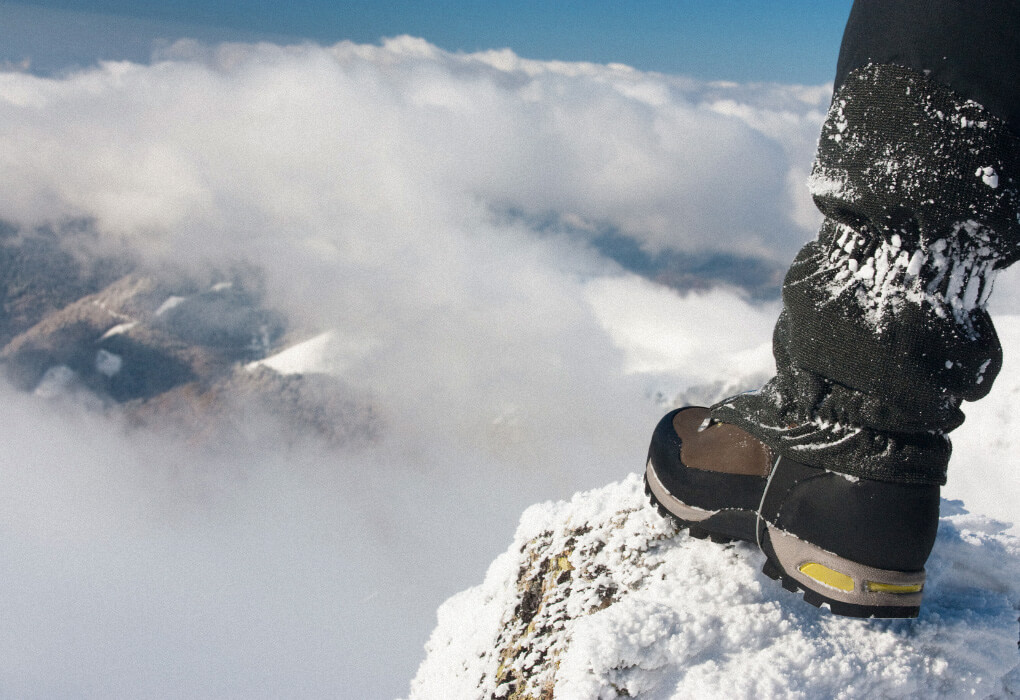
In my opinion, waterproofing is the most important feature in ice fishing boots. It doesn’t matter how warm the boots are if they’re not keeping the snow and slush out.
You need boots that are snug around your calves so you can walk through deep snow, and they need to be solid all-around, so no weak points allow any moisture to get inside.
Remember that just a little bit of snow getting in could be enough to cause frostbite if your toes get wet. So, how do you tell if the boots are waterproof?
The first thing I look for is a single-piece shell. I love when rubber boots are made with one piece of 100% rubber. It limits any weak spots from seams that may wear down over time and allow water in.
Another factor you look for is the fit at the top. Many boots use an elastic band or drawstrings to tighten around your calves. Any ice angler knows that a little wind will blow snow into any opening around your legs, so this needs to be snug.
Lastly, the best ice fishing boots will have moisture-wicking properties so they not only keep cold air out, but they help dry sweaty feet as part of the inner boot system. This is why breathability is such an important factor. When boots lack moisture-wicking properties, your feet can sweat leading to skin peeling, infection, or worse.
Height and Fit
Most of the boots you’ll find in this review are longer than 10 inches from heel to collar, and I wouldn’t really recommend anything shorter unless you’re shorter than five feet in height. You need to make sure you’re prepared to walk to the ice through high snow.
The fit of the boots is another factor. The only way to guarantee the boots will fit perfectly is to try them on, and most of us don’t have that luxury. When you’re shopping for boots for ice fishing online, you need to trust the reviews of others.
Even with the best ice fishing boots, you’ll still want to wear at least one pair of thick socks. I’ve found that many ice fishing boots run smaller than you would expect, so you’ll want to go up a size. I think the reason is that they don’t compensate for layers of heavy socks.
Traction

You need good traction in the snow or you’ll regret it. The ice becomes very slippery, especially when it has just enough snow to cover it. While no boot will completely prevent you from slipping, you want ice fishing boots with enough grip that you can drag your foot across the ice and now glide like a ski.
If you’re really concerned about slipping, you can get the best ice fishing boots with cleats, but I was surprised to find that very few boots actually come with metal cleats anymore.
Conclusion
There’s a reason why the Korkers Polar Vortex 1200 boots make the top of the list even in 2025. They’re waterproof, incredibly durable, and versatile enough for every ice fishing situation you’ll find yourself in.
If cost is a factor, I recommend the ArcticShield Cold Weather Snow Boots because despite their low price, they still offer adequate weatherproofing and protection in sub-zero temperatures.
The Baffin Men’s Titan Boots are some of my favorites simply because they’re good for temperatures as low as -148F. You may not be fishing in temps this low, but if a cheap pair of boots get wet, your feet can get pretty cold, pretty fast.
If you have any additional questions or need help, drop a comment below and I’ll get back to you ASAP.
I monitor and reply to each comment that comes in!
Frequently Asked Questions
Do you really need special boots for ice fishing?
Yes, you need to get special boots for ice fishing. Regular winter boots won’t cut it. Ice fishing boots are designed to handle specific challenges like standing water, deep slush, and extreme cold.
They’re built with specialized traction for walking on ice. While you could try using regular winter boots with extra socks, you won’t enjoy the result.
Do you need ice cleats for the boots?
No, you don’t need ice cleats, but they’ll help. It’s a matter of personal choice. If you’re concerned about falling or you have limited mobility, a pair with cleats might be the best choice for you.
How can I prevent snow from getting into the boots from the top?
The best way to prevent snow from getting into your boots is with an ice fishing bib. It’s essentially an overloaded pair of waders designed for cold weather and they usually tie around the legs.
If you add that to the elastic containment of your ice fishing boots, you should have enough protection to ensure that no snow or water gets inside.

